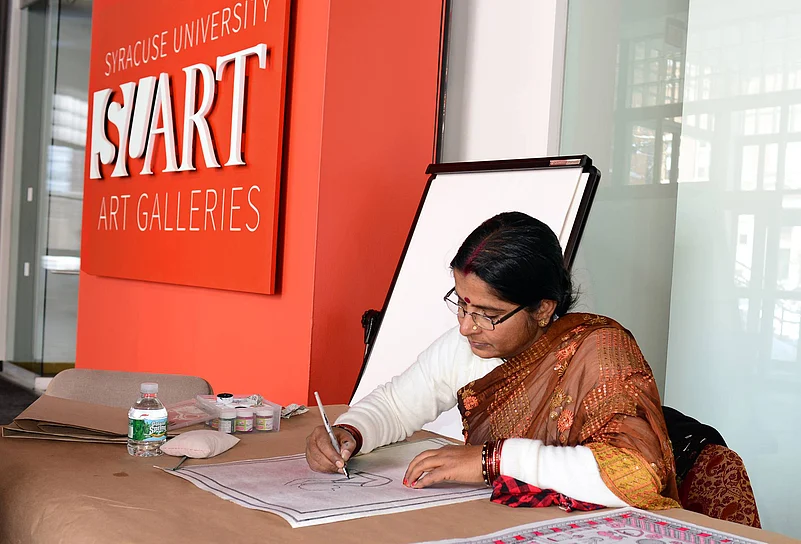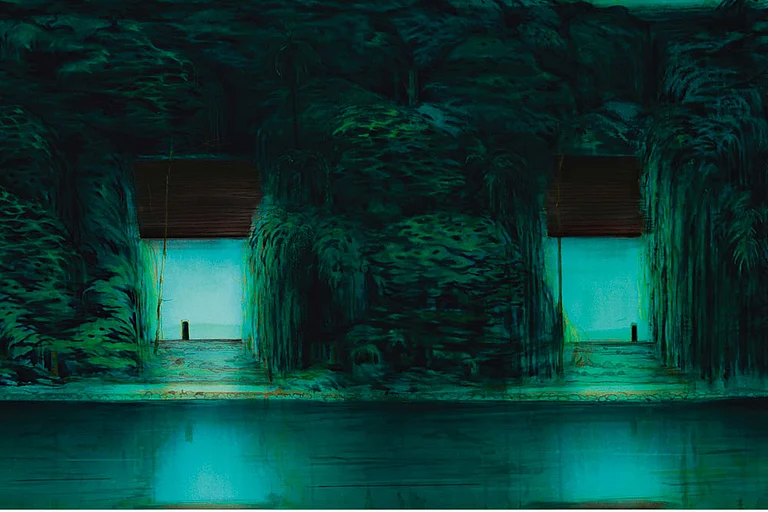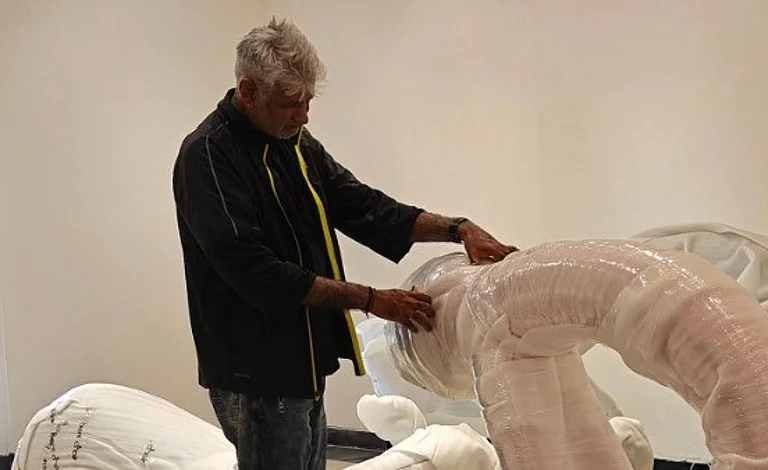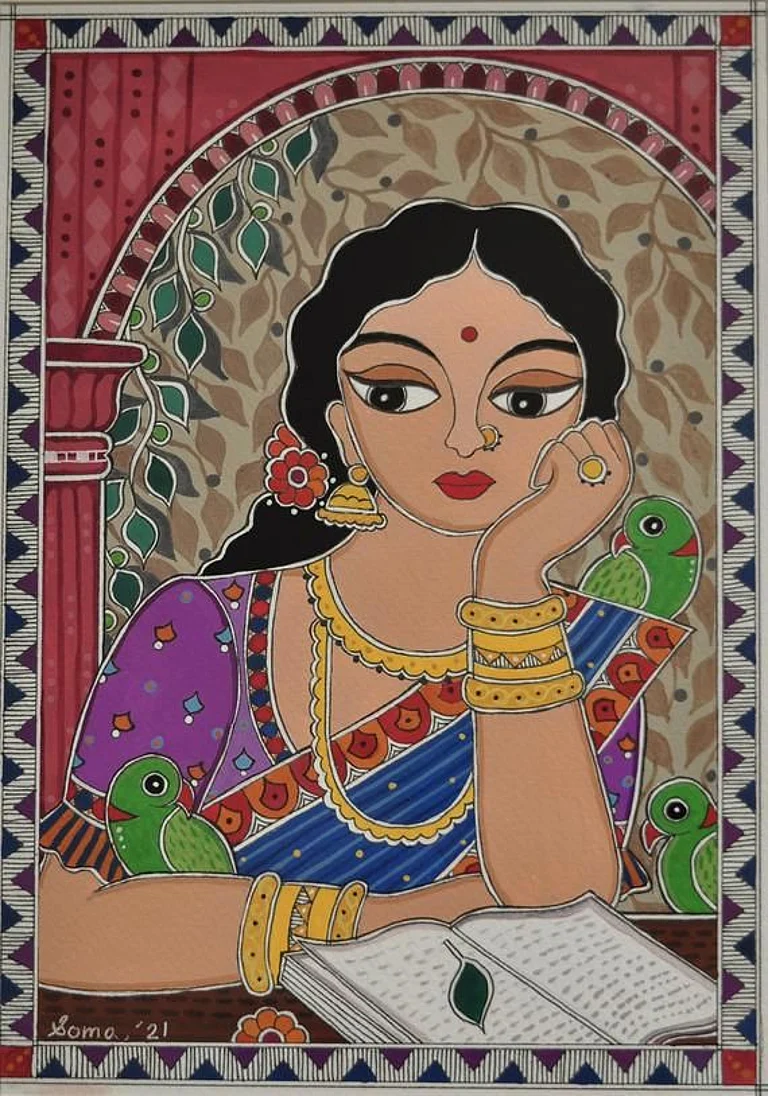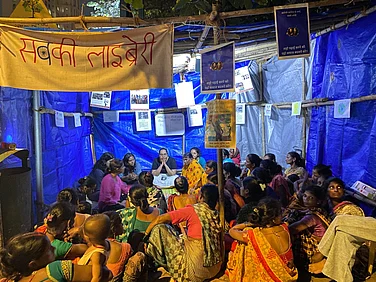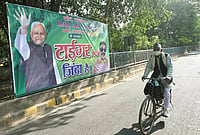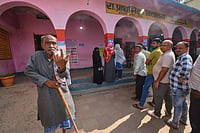Rani Jha, a distinguished Madhubani artist and scholar, holds a PhD on the Contribution of Women in Mithila Painting and Literature from LNMU Darbhanga (2010). Rooted in ancient ritual and tradition, Rani Jha’s artistic strength lies in her ability to express profound social issues with depth, particularly those close to her heart, focusing on women's themes.
Rani Jha teaches at the Mithila Chitrakala Sansthan, Saurath in Madhubani, Bihar.
Ashutosh Kumar Thakur recently spoke to Rani Jha, about her journey as an artist and the various aspects of Madhubani Painting.
Can you share with us some memories from your early life that influenced your decision to become a Madhubani Painting artist, and how did your academic journey contribute to your artistic path?
My name is Rani Jha, and I am an artist and art teacher. Coming from a lower-middle-class family, my education took place entirely in a rural environment. I inherited my talent for painting from my father's side and my gift for singing from my mother's side. I sing traditional folk songs and often translate these songs into visual art, especially those related to Sita.
One of my greatest influences was my late grandmother, Late Buchhni Devi, who used to draw 'Likhia' beautifully. Her work was so remarkable that a photograph of one of her murals, taken by W.G Archer (A British Art Historian), is now dedicated to the British Library in London.
My academic journey has also played a significant role in shaping my artistic path. Higher education provided me with a new perspective on painting, inspiring me to dig deep into its theoretical aspects as well as its practical ones.
Could you briefly share the history of Madhubani Painting, both in its early and modern forms, for our readers?
The foundation of the modern history of Madhubani Painting is deeply rooted in its early history. This tradition has been part of Mithila since ancient times. The paintings discovered on mud walls after the 1934 earthquake were merely a glimpse of a centuries-old painting tradition ingrained in the ethos of Mithila. It was a coincidence that the devastating earthquake brought this tradition to the world's attention, and during the famine of the 1970s, this 'art' gradually found its way into the art market.
From 1960 to 2000 AD, Madhubani Painting largely retained its traditional form. However, within these forty years, some artists introduced slight changes in their themes using the 'Kachni' style. Prominent among them were Padma Shri Ganga Devi, Padma Shri Godavari Dutt, and Smt. Lalita Devi. Ganga Devi, for instance, depicted scenes from her travels to Japan in her art.
Godavari Dutt took a chance from traditional paintings and made extraordinary experiments, such as drawing an innovative design of a single trident in the ‘Kachni’ style. Traditionally, artists depicted Shiva with a trident (Ek Trishul), but no one had presented just a trident as a standalone subject before. Godavari Dutt's experiments included depictions of Sudarshan, Dhanush, and Basuki Nag, all of which can be seen in the Mithila Museum in Japan.
Similarly, Smt. Lalita Devi (from Simri - Rajnagar) introduced changes in the subject matter of her paintings on the suggestion of Mrs. Gauri Mishra, the founder of SEWA-Mithila. Her works included themes like 'Environment and We' and 'Women's Self-Reliance'.
In 2003, American anthropologist and art’s research scholar Raymond Owens' colleague, David Szanton of the Ethnic Art Foundation in New Jersey, founded the Mithila Art Institute on Mahila College Road in Madhubani. This institute, established by Dr. Parmeshwar Narayan Jha and his wife Mrs. Vibha Jha, prepared a new generation of artists. Here, traditional paintings were created alongside those addressing contemporary subjects. A new style of Mithila painting emerged, which was well-received in the international art market. While efforts were made to maintain the basic style of these paintings, the subjects were updated, balancing traditional gestures and postures with new themes.
It's important to note that if the early history of Madhubani painting reflects its spiritual essence, the modern history is intertwined with its commercialization. Originally, women made these paintings for spiritual fulfillment and self-satisfaction. With commercialization, financial aspects have become intertwined with the art, which is a positive development.
Change is eternal, and I agree that paintings must evolve. However, I am aware that this evolution sometimes leads the art towards fine art, diverging from its traditional roots.
Could you please share insights into the early days of Madhubani Painting and the pioneering artists such as Jagdamba Devi, Sita Devi, and Ganga? How did their contributions shape the foundation of this art form?
The lucid expression of the paintings by the great artists captured the world's attention. The introduction of Madhubani Paintings to the global art market was an epoch-making event in Mithila society. For centuries, the women of Mithila had been financially dependent on men, a deeply ingrained tradition with little interference. However, through this art, women began moving towards self-reliance.
The impact of these pioneering artists was significant. Jagdamba Devi, Sita Devi, and Ganga Devi became known by their own names rather than being identified merely as someone's daughter-in-law or wife. The recognition and respect they received from both the government and society boosted their confidence immensely. Financial self-reliance empowered them to make decisions within their families, and their opinions started being taken seriously.
Whereas local people once dismissed the artistic efforts of women as inconsequential, the scenario transformed entirely. The blackness of their hands, previously taken lightly, came to symbolize their strength and autonomy. This shift not only elevated the status of these women but also revolutionized the perception and role of women in Mithila society.
How do you view the artistic expressions of Jagadamba Devi, Sita Devi, Ganga Devi, and other important artists of their time? How did their contributions shape the global foundation of this art?
The artistic expressions of early practitioners such as Jagdamba Devi, Sita Devi, and Ganga Devi hold immense significance in the evolution of Madhubani painting.
The paintings of Padma Shri Jagadamba Devi, Padma Shri Ganga Devi, and other artists of their era each have their own specialties. Jagadamba Devi and Sita Devi were known for their 'Bharani style', characterized by the predominant use of pink, red, ochre, yellow, and orange colors. The occasional use of ‘dark blue’ breaks the monotony and creates a mesmerizing effect in their artwork. The structural differences in the figures they depicted are also distinctly visible.
Jagadamba Devi's human figures are notable for their curved postures and the use of 'double lines' between the neck and waist, which give her paintings a solid and dynamic look. Sita Devi’s paintings feature tall body shapes with intricate decorations, including distinctive jewelry designs and elaborate hairstyles for the female figures.
Padma Shri Ganga Devi's work is astonishing for its detailed shapes and designs made from straight lines. In addition to the 'Bharani style', she established the 'Kachni' style. Among her contemporaries, the National Award-winning artist Jamuna Devi also innovated with new design styles. Her paintings are characterized by outline lines made from ‘thick cow dung solution’, the use of bright colors, and round dots (Bindi) for decoration, giving her work a distinctive appearance.
A common trait among all the artists of that time is 'spontaneity'. They did not strive for perfection; their paintings, created with complete sincerity and authenticity, exude a calm and sweet demeanour. This genuine approach allows their artwork to communicate with art’s passionate in a lively and engaging manner.
I must add, the contributions of these pioneering artists played a crucial role in bringing worldwide recognition to Madhubani painting. Their self-developed styles and innovations helped establish a strong foundation for this art form on the international stage.
What are your thoughts on the evolution of Madhubani Painting from being created on the walls of 'mud houses to its present expression on paper' and other mediums?
Initially, Madhubani art adorned 'Aripan' paintings in courtyards and murals on house walls. However, over time, it transcended these boundaries, moving from walls to paper and beyond, breaking free from the confines of the courtyard.
The legacy of these pioneering artists is profound. Their original styles and innovations laid the foundation for Madhubani Painting’s global acceptance. Today, this art form is celebrated in national and international museums and art galleries, bringing joy and pride to its admirers. The transformation and widespread acceptance of Madhubani painting reflect the eternal nature of change, marking its journey not just across centuries but through different eras.

As a Madhubani Painting artist, you paint both traditional and contemporary themes. How do you balance preserving the authenticity of traditional art while incorporating modern elements to address current social issues?
I try to maintain a balance by incorporating the enduring and valuable aspects of our tradition into my paintings, ensuring their relevance continues. One of my paintings, 'Pokhair Ghat (Pond’s Ghat),' addresses the crucial issue of water conservation. Traditionally, our culture in Mithila included ‘ponds and wells’ in every village. These water sources ensured the entire village had access to water for their daily uses and helped maintain a constant water level, effectively conserving water.
Unfortunately, this practice has diminished over time, contributing to the ongoing global water crisis. Through 'Pokhair Ghat,' I aim to highlight and revive our traditional culture of water conservation, demonstrating how our heritage can offer solutions to modern issues.
Could you describe the significance of specific traditional Madhubani themes you often paint, such as Sita Swayamvar, Janak Phulwari, Radha-Krishna, and Kaliya Daman? How do these themes connect with contemporary elements in your work?
Among the subjects of our traditional paintings, artists have historically chosen themes that convey auspiciousness, joy, and enthusiasm. I strive to infuse these feelings into my traditional paintings while also adding a contemporary twist through the power of my imagination.
For instance, in my 'Janak Phulwari' painting, which illustrates the first meeting of Ram and Sita in the garden, I have intentionally left a space between their eyes. This symbolizes the purity of their union, suggesting that nothing should come between this sacred connection.
Similarly, I paint the union of Radha and Krishna with great sensitivity. While maintaining the decorum of physical representation, I use symbolic elements to illustrate their union, such as 'wrapped vines around a tree,' 'a bumblebee kissing a lotus,' and 'birds embracing in pairs.' These motifs convey the intimacy and connection between Radha and Krishna in a respectful and evocative manner.
By blending these traditional themes with contemporary elements, I try to preserve the authenticity of Madhubani Painting while making it relevant to modern audiences.
Your contemporary paintings touch upon sensitive topics like abortion, migration, and the role of women in Mithila society. What motivates you to address these issues through your art, and how has the response been from people or art historians?
I immerse myself in my environment, and whatever I observe happening around me, I express through my paintings. I have witnessed daughters dying in the womb, youth leaving villages to seek livelihoods in cities, and the plight of women in our society. These experiences deeply disturb me, and to cope with my anxiety, I create paintings like
Abortion Clinic', 'Migration', 'Tearing the Veil', 'Parents Forced from Home', and 'Changing the Women's Cage'.
I am gratified that my voice has reached far and wide. On one hand, Aamir Khan's Satyamev Jayate took cognizance of these paintings, and on the other hand, they have sparked discussions in foreign countries.
I have received awards and honors from various institutions, including State Awards, but I have yet to receive any recognition from the Government of India. I am still hopeful and waiting for that acknowledgment.

Can you provide some insights into your creative process? How do you determine the themes for your paintings, and what techniques do you utilize to convey profound emotions in your artwork?
When it comes to selecting themes for my paintings, I begin by conducting thorough research. For traditional or mythological subjects, I read relevant books and engage in conversations with people to ensure I understand the nuances and intricacies involved. This preliminary work is crucial in allowing me to do justice to the chosen subjects.
Once I have a deep understanding of the subject matter, I infuse it with contemporary relevance, giving it my own interpretation. Sometimes, I convey messages symbolically, while at other times, I address issues directly through my artwork.
Considering other remarkable Madhubani artists like Mahasundari Devi, Karpoori Devi, and Godavari Dutta, how would you relate their work to feminist ideologies and expressions? Are there specific themes or styles that highlight a feminist approach in their creations?
A unique perspective on feminism is evident in the artworks of these artists, reflecting a deep sense of pride in their culture. Through depictions of deities such as Kali, Durga, Sita, and Radha, they artistically assert their identity and self-respect with fervor.
This style of presenting their views embodies a distinct form of feminism, diverging from conventional interpretations.
This can be easily observed in the works of Padma Shri Mahasundari Devi, Padma Shri Godavari Dutt, and Smt. Karpoori Devi.
In the context of Madhubani Painting, how would you characterize the immense contributions of contemporary well-known artists like Dulari Devi and Baua Devi? What aspects of their art do you find particularly distinctive?
The environment of any artist invariably influences their work, and for Dulari Devi and Baua Devi, this rings true in their distinctive contributions to Madhubani painting. Rooted in the geographical, cultural, and social fabric of Mithila, their creativity reflects their surroundings and experiences.
Padma Shri Baua Devi's art delves into geographical and cultural aspects through the lens of 'Naag-Katha,' weaving narratives that echo with local traditions. On the other hand, Padma Shri Dulari Devi draws inspiration from her immediate environment, portraying scenes of rivers, ponds, and the worship of folk goddess ‘Kamla Maiya’. In addition to capturing the essence of her surroundings, Dulari Devi's work also serves as a voice against social injustices, as seen in her painting of ‘systemic discrimination against patients’.
Baoua Devi's colour combination enchants my soul!
Godavari Dutt's portrayal of nature's essence and her intricate designs cast a spell upon me, while Dulari Devi’s paintings with a touch of nature's grace, beckon me with their effortless charm.
Are there specific artists, mentors, or experiences that have profoundly influenced your artistic journey? How have they shaped your approach to Madhubani painting?
During my childhood, I was fascinated by the sight of my cousin's grandmother, Late Bindul Devi, effortlessly drawing intricate geometric patterns on the ground using ‘Pithar,’ a thick solution made from grinding wet rice, for writing 'Aripan' on various occasions. It was from her that I first learned the art of painting.
Around 1990, amidst challenging circumstances, my aunt, Late Veena Jha, became a guiding light in my life. She encouraged me by entrusting me with painting tools and materials, affirming that there was an artist within me waiting to be unleashed. Her words ignited a spark within me, and I started on a journey of self-discovery through art.
Since then, my approach to Madhubani painting has been shaped by a commitment to continuous learning and exploration. I have dedicated myself to delving deeper into the nuances of this art form, aiming to broaden my understanding and refine my skills. Each experience, whether learning from mentors or overcoming challenges, has played a significant role in shaping my artistic journey.
As a prolific Maithili poet, how does your poetry contribute to the narrative surrounding Madhubani art, and do you find that your written work influences your visual art or vice versa?
Indeed, I am also a poet. I often find that certain words or expressions from my poems resonate in my paintings. Conversely, while observing my artwork, words and emotions sometimes emerge spontaneously, inspiring me to craft them into poems. This symbiotic relationship between my poetry and visual art reflects the interconnectedness of both forms of expression in my creative journey.
Could you please highlight some of your notable achievements, particularly your participation in art exhibitions on both national and international platforms?
I have had the privilege of participating in art exhibitions across various metropolitan cities in India as well as internationally, including the United States. It has been immensely gratifying to witness the appreciation and admiration from art enthusiasts, historian, and collectors for my paintings during these exhibitions.
In your opinion, how has Madhubani painting evolved over the years, and where do you see it heading in the next two decades, both in terms of artistic styles and its impact on society?
Over the past decades, Madhubani painting has undergone various experiments and transformations. There has been a noticeable shift towards catering to market demands, leading to changes in style and structure. However, this evolution has also led to a departure from the spontaneity and authenticity of traditional or early paintings, as evident when comparing contemporary works with those preserved in museums.
While change is inevitable and often beneficial, it is crucial to preserve the original essence of Madhubani painting. Despite evolving themes, maintaining the integrity of the original style enhances the beauty and cultural significance of the art form. In the coming decades, I envision a balance between innovation and tradition, where new themes are explored while respecting the foundational elements of this art form.
What is your message to the young artists who are continuously working to enrich the art of Madhubani painting?
To the young artists dedicated to enriching the art of Madhubani painting, I offer a simple, yet profound message is while exploring new themes and perspectives, remember to preserve the originality that is the soul of this art form. By infusing fresh vision into their work while honoring its traditional roots, they can contribute to the continued vibrancy and relevance of Madhubani painting. I believe this approach will benefit us all.
(Ashutosh Kumar Thakur is a Bengaluru-based Management Professional, Literary Critic, and Curator)






